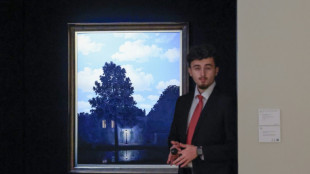
-
 India and Nigeria renew ties as Modi visits
India and Nigeria renew ties as Modi visits
-
Grit and talent, a promise and a dilemma: three things about Jorge Martin

-
 Martin denies Bagnaia to win first MotoGP world championship
Martin denies Bagnaia to win first MotoGP world championship
-
Typhoon Man-yi weakens as it crosses Philippines' main island

-
 Noel wins season-opening slalom in Levi as Hirscher struggles
Noel wins season-opening slalom in Levi as Hirscher struggles
-
Tough questions for England as Springboks make it five defeats in a row

-
 Russia pounds Ukraine with 'massive' attack in 'hellish' night
Russia pounds Ukraine with 'massive' attack in 'hellish' night
-
McIlroy clinches Race to Dubai title with DP World Tour Championship win

-
 Glastonbury 2025 tickets sell out in 35 minutes
Glastonbury 2025 tickets sell out in 35 minutes
-
迪拜棕榈岛索菲特美憬阁酒店: 五星級健康綠洲

-
 The Retreat Palm Dubai MGallery by Sofitel: Пятизвездочный велнес-оазис
The Retreat Palm Dubai MGallery by Sofitel: Пятизвездочный велнес-оазис
-
New Zealand win revives France on their road to 2027 World Cup

-
 The Retreat Palm Dubai MGallery by Sofitel: A five-star wellness Oasis
The Retreat Palm Dubai MGallery by Sofitel: A five-star wellness Oasis
-
Israel hits Gaza and Lebanon in deadly strikes

-
 Power cuts as Russian missiles pound Ukraine's energy grid
Power cuts as Russian missiles pound Ukraine's energy grid
-
Denmark's Victoria Kjaer Theilvig crowned Miss Universe 2024

-
 Dutch police use hologram to try and decode sex worker's murder
Dutch police use hologram to try and decode sex worker's murder
-
Israel bombs south Beirut after Hezbollah targets Haifa area

-
 Biden in historic Amazon trip as Trump return sparks climate fears
Biden in historic Amazon trip as Trump return sparks climate fears
-
India hails 'historic' hypersonic missile test flight

-
 Israel orders Beirut residents to flee after Hezbollah targets Haifa area
Israel orders Beirut residents to flee after Hezbollah targets Haifa area
-
Davis, LeBron power Lakers over Pelicans as Celtics win in OT

-
 Trump and allies return to New York for UFC fights
Trump and allies return to New York for UFC fights
-
Hong Kong political freedoms in spotlight during bumper trial week

-
 Debt-saddled Laos struggles to tame rampant inflation
Debt-saddled Laos struggles to tame rampant inflation
-
Senna, Schumacher... Beganovic? Macau GP showcases future F1 stars

-
 India's vinyl revival finds its groove
India's vinyl revival finds its groove
-
G20 tests Brazil's clout in Lula 3.0 era

-
 Over 20,000 displaced by gang violence in Haiti: UN agency
Over 20,000 displaced by gang violence in Haiti: UN agency
-
Famed gymastics coach Bela Karolyi dies

-
 'Break taboos': Josep Borrell wraps up time as EU's top diplomat
'Break taboos': Josep Borrell wraps up time as EU's top diplomat
-
Climate finance can be hard sell, says aide to banks and PMs

-
 Trump revives 'peace through strength,' but meaning up to debate
Trump revives 'peace through strength,' but meaning up to debate
-
New York auction records expected for a Magritte... and a banana

-
 Egypt's middle class cuts costs as IMF-backed reforms take hold
Egypt's middle class cuts costs as IMF-backed reforms take hold
-
Beirut businesses struggle to stay afloat under Israeli raids

-
 Dupont lauds France 'pragmatism' in tight New Zealand win
Dupont lauds France 'pragmatism' in tight New Zealand win
-
Swiatek leads Poland into maiden BJK Cup semi-final

-
 Trump taps fracking magnate and climate skeptic as energy chief
Trump taps fracking magnate and climate skeptic as energy chief
-
West Indies restore pride with high-scoring win over England

-
 Hull clings to one-shot lead over Korda, Zhang at LPGA Annika
Hull clings to one-shot lead over Korda, Zhang at LPGA Annika
-
Xi tells Biden ready for 'smooth transition' to Trump

-
 Trump nominates fracking magnate and climate skeptic as energy secretary
Trump nominates fracking magnate and climate skeptic as energy secretary
-
Tyson says 'no regrets' over loss for fighting 'one last time'

-
 Springboks' Erasmus hails 'special' Kolbe after England try double
Springboks' Erasmus hails 'special' Kolbe after England try double
-
France edge out New Zealand in Test thriller

-
 Xi tells Biden will seek 'smooth transition' in US-China ties
Xi tells Biden will seek 'smooth transition' in US-China ties
-
Netherlands into Nations League quarter-finals as Germany hit seven

-
 Venezuela to free 225 detained in post-election unrest: source
Venezuela to free 225 detained in post-election unrest: source
-
Late Guirassy goal boosts Guinea in AFCON qualifying


Nobel-winning lithium battery inventor John Goodenough dies at 100
John Goodenough, who shared the 2019 Nobel Prize in Chemistry for developing the lithium-ion battery that revolutionized modern life, has died at the age of 100, the University of Texas announced.
Goodenough died on Sunday, said the university, where he worked as an engineering professor.
The US scientist's contributions to the development of lithium-ion batteries paved the way for smartphones and a fossil fuel-free society.
"John's legacy as a brilliant scientist is immeasurable -- his discoveries improved the lives of billions of people around the world," Jay Hartzell, president of the University of Texas at Austin, said in the statement.
"He was a leader at the cutting edge of scientific research throughout the many decades of his career."
In 1986, at the age of 64, Goodenough joined the University of Texas where he served as a faculty member in the Cockrell School of Engineering for 37 years.
"The world has lost an incredible mind and generous spirit. He will be truly missed among the scientific and engineering community, but he leaves a lasting legacy that will inspire generations of future innovators and researchers," said Sharon Wood, provost of the University of Texas.
Goodenough became the oldest person to win a Nobel Prize when at the age of 97 he shared the 2019 chemistry award with Britain's Stanley Whittingham and Akira Yoshino of Japan for the invention of the lithium-ion battery.
Seeking an alternative source of power during the oil crisis of the 1970s, Whittingham discovered a way to harness the potential energy in lithium, a metal so light it floats on water.
However, the battery he constructed was too unstable to be used.
Goodenough built on Whittingham's prototype, substituting a different metal compound and doubling the potential energy of the battery to four volts.
This paved the way for far more powerful and durable batteries in the future.
In 1985, Yoshino instead used a carbon-based material that stores lithium ions, finally rendering the battery commercially viable.
The culmination of the trio's research resulted in the most powerful, lightweight and rechargeable battery ever seen.
- 'A rechargeable world' -
"They created a rechargeable world," the Royal Swedish Academy of Sciences, which awarded the accolade, said at the time.
"Lithium batteries have revolutionized our lives since they first entered the market in 1991," and were "of the greatest benefit to humankind".
Their work considerably boosted human mobility, and allowed millions in developing countries to access information and services online with just a mobile phone.
Lithium-ion batteries have also reduced the reliance on planet-warming fossil fuels, especially in electric cars.
On receiving news of his Nobel, Goodenough expressed pride in the worldwide impact of his work.
"I'm extremely happy that my discovery has been able to help communication through the world," he said.
"We need to build relationships, not wars. I am happy if people use this for good, not evil."
Born in 1922 in Germany, Goodenough grew up in the United States and earned a bachelor's degree in mathematics from Yale University.
After serving as a meteorologist in the US Army during World War II, Goodenough earned a master's degree and a PhD in physics at the University of Chicago in 1952, according to the University of Texas statement.
From 1952, he worked at the Massachusetts Institute of Technology's Lincoln Laboratory for 24 years and laid the groundwork for the development of computer random-access memory (RAM).
Goodenough was head of the inorganic chemistry laboratory at Oxford University when he made his lithium-ion battery discovery.
In 1986, he joined the University of Texas where he was known for his "quick wit and infectious laugh."
He was still coming into work well into his 90s, the university said.
Goodenough and his wife Irene were married for 70 years, until her death in 2016.
J.Gomez--AT



